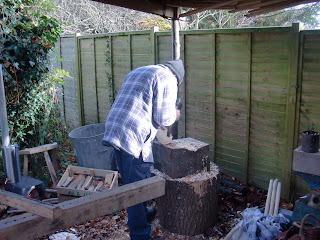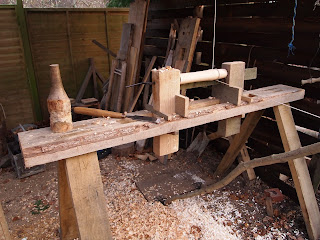Training day for Mike and Bob
One of the favorite things I do is to talk about making
bowls and what better way than to pass on skills to others, so having Bob and
Mike round was a pleasure.
Making a bowl from scratch in a day for the first time is a lot to
ask as the skill set is a leap up from spindle turning as the hollowing has
many different angles at which the hook tool is being used to make the fine
planing cuts that are needed.
So we first started with a one-month old log of Silver
birch. It is not what I would call
mellow but fresh. Normally for a timber
such as birch I would normally leave to mellow for at least three months but will
have used it up by say nine months before it starts to rot or dry out. In previous tests of fresh birch, I have
found it to give a very good finish and a very clean bowl.
 | |||||
| Bob axing out a blank of birch. |
 |
| Mike also axing out a blank. |
Preparing the blank comes first and it is important to spend
enough time so as to end up with a blank that will only take two turning passes
to remove all of the axe marks. My two
rules are to axe as close as possible to the scribed line (within a millimeter)
and to remove all the high “hills” so as to make as true as possible, a half
sphere. Once this has been achieved the
mandrel is set on the flat top side of the bowl and installed onto the lathe
ready to turn.
 |
| Base completed, now hollowing. |
The main rules of hook turning is to keep the cutting angle
of the hook tool close to the wood so the back bevel stops the cut getting deeper
and to make sure the hook of the tool is rotated so the amount of cutting is
reduced. If the cutting tool is allowed
to cut too much, then dig-ins, spiralling and bad finish will result.
 |
| Some nice clean turning. |
 |
| Beautifully hollowed out and ready to seperate. |
So both Mike and Bob breezed through all this to complete a
finished bowl, besides plenty of tea coffee and of course a warming soup for
lunch. We all had a great time and I
believe Mike and Bob will be practicing frantically as soon as they get
home! They even went home with some
extra blanks so they have no excuses! So
thank you both and hope the bowling is going well!









